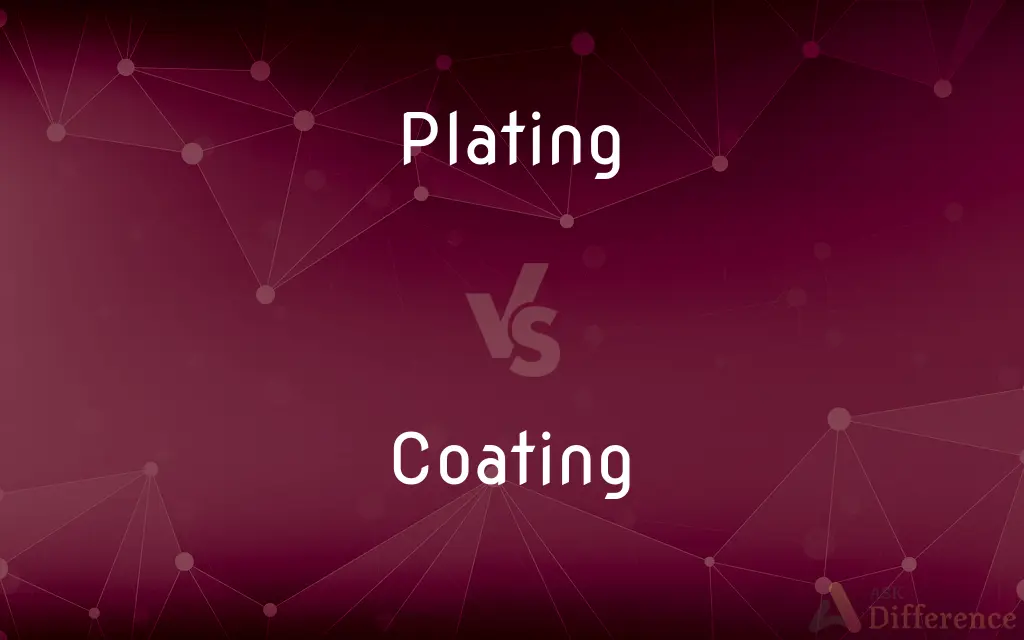Plating vs. Coating — What's the Difference?
By Fiza Rafique & Urooj Arif — Updated on March 13, 2024
Plating involves adding a metal layer to a surface through electrochemical processes, enhancing durability and appearance, while coating encompasses a broader range of materials and methods for surface protection and aesthetics.

Difference Between Plating and Coating
Table of Contents
ADVERTISEMENT
Key Differences
Plating specifically refers to the process of depositing a metal layer onto a substrate using electrochemical means, such as electroplating, where an electric current reduces dissolved metal cations to form a coherent metal coating. On the other hand, coating includes not just metal deposition but also the application of polymers, ceramics, paints, or any protective layer applied by various methods like spraying, brushing, or dipping to protect or decorate a surface.
The purpose of plating often centers on improving wear resistance, corrosion protection, and aesthetic qualities of metal parts, by adding layers of precious or more durable metals like gold, silver, or nickel. Whereas coating aims not only to protect surfaces from corrosion and wear but also to add color, improve texture, or even provide insulation against electricity and heat, using materials that range widely from latex paints to rubber-like coatings.
Plating processes are generally more specialized and require controlled electrochemical environments, making them ideal for conductive materials. Coating, however, can be applied to a broader range of substrates, including metals, plastics, fabrics, and wood, with techniques varying based on the material of both the coating and the substrate.
While plating is limited to materials that can conduct electricity or be made to do so, coating technologies offer more versatility in terms of application methods (e.g., physical vapor deposition for non-conductive materials) and the variety of materials that can be applied, including non-metallic options.
In terms of environmental impact, traditional plating processes can produce hazardous waste and require significant water and energy use. Coating methods, especially those involving organic compounds, also face environmental scrutiny but have seen advancements in reducing volatile organic compounds (VOCs) emissions and developing more eco-friendly alternatives.
ADVERTISEMENT
Comparison Chart
Materials Used
Metals
Metals, polymers, ceramics, etc.
Application Method
Electrochemical deposition
Spraying, dipping, brushing, etc.
Substrate Compatibility
Conductive surfaces
Wide range, including non-conductive
Main Purpose
Enhance durability, corrosion resistance, appearance
Protect, decorate, provide special surface properties
Environmental Impact
Hazardous waste, water, and energy use
VOC emissions, but advancements in eco-friendly options
Compare with Definitions
Plating
The process of depositing a metal layer onto a surface using electricity.
Silver plating is commonly used for jewelry to enhance its appearance.
Coating
The application of a substance over a surface for protection or decoration.
A polymer coating can protect outdoor furniture from weathering.
Plating
Requires a conductive substrate.
Electroplating cannot be directly applied to plastic without making it conductive first.
Coating
Applied by different methods such as spraying, dipping, or brushing.
Spray painting is a common method for applying a coating to metal surfaces.
Plating
Involves electrochemical processes to achieve a durable finish.
Nickel plating on car parts improves their resistance to corrosion.
Coating
Can involve a variety of materials including paints, polymers, and ceramics.
Ceramic coatings are used on spacecraft for thermal protection.
Plating
Can enhance electrical conductivity.
Gold plating is often applied to electronics connectors for better conductivity.
Coating
Suitable for a wide range of substrates.
Wood furniture is often coated with varnish for protection and aesthetic enhancement.
Plating
Used for decorative and functional purposes.
Chrome plating gives a shiny finish to automotive parts.
Coating
Offers insulation against heat and electricity.
Rubber coatings are used on tools for electrical insulation.
Plating
Plating is a surface covering in which a metal is deposited on a conductive surface. Plating has been done for hundreds of years; it is also critical for modern technology.
Coating
A coating is a covering that is applied to the surface of an object, usually referred to as the substrate. The purpose of applying the coating may be decorative, functional, or both.Paints and lacquers are coatings that mostly have dual uses of protecting the substrate and being decorative, although some artists paints are only for decoration, and the paint on large industrial pipes is presumably only for the function of preventing corrosion.
Plating
A thin layer of metal, such as gold or silver, deposited on or applied to a surface.
Coating
A layer of a substance spread over a surface as for protection or decoration; a covering layer.
Plating
A coating of metal sheets or plates.
Coating
Cloth for making coats.
Plating
Present participle of plate
Coating
A thin outer layer.
They painted on a coating to protect it from the weather.
Plating
(philately) An act of determining where a postage stamp is positioned on a sheet.
Coating
(archaic) Cloth for making coats.
Plating
A thin coating of metal laid upon another metal.
Coating
A telling-off; a reprimand.
Plating
A coating or defensive armour of metal plates.
Coating
Present participle of coat
We spent hours coating the truffles with cocoa powder so they wouldn't be sticky.
Plating
The presentation of food that is ready to be served.
Coating
A coat or covering; a layer of any substance, as a cover or protection; as, the coating of a retort or vial.
Plating
The art or process of covering anything with a plate or plates, or with metal, particularly of overlaying a base or dull metal with a thin plate of precious or bright metal, as by mechanical means or by electro-magnetic deposition.
Coating
Cloth for coats; as, an assortment of coatings.
Plating
A thin coating of metal laid upon another metal.
Coating
A thin layer covering something;
A second coat of paint
Plating
A coating or defensive armor of metal (usually steel) plates.
Coating
A decorative texture or appearance of a surface (or the substance that gives it that appearance);
The boat had a metallic finish
He applied a coat of a clear finish
When the finish is too thin it is difficult to apply evenly
Plating
A thin coating of metal deposited on a surface
Coating
A heavy fabric suitable for coats
Plating
The application of a thin coat of metal (as by electrolysis)
Coating
The work of applying something;
The doctor prescribed a topical application of iodine
A complete bleach requires several applications
The surface was ready for a coating of paint
Common Curiosities
What is the main difference between plating and coating?
Plating specifically involves the deposition of a metal layer onto a surface through electrochemical processes, while coating refers to applying a protective or decorative layer that can be made of various materials.
Are all coatings protective?
While many coatings are designed for protection against wear, corrosion, or environmental factors, others are primarily decorative or functional (e.g., for insulation).
Is plating more durable than coating?
Plating can offer superior durability and wear resistance for certain applications, but the durability of a coating also depends on the material used and the application method.
Can plating be done on non-metal surfaces?
Yes, but non-metal surfaces typically require a conductive layer or a special process to allow for electroplating.
Is environmental impact a concern for both plating and coating?
Yes, both processes can have environmental impacts, but there are ongoing efforts to develop more eco-friendly plating solutions and coatings with lower VOC emissions.
Can coatings be conductive?
Yes, some coatings are designed to be conductive, such as conductive paints and coatings used in electronics and shielding applications.
Are there non-chemical methods for applying coatings?
Yes, physical methods like physical vapor deposition (PVD) can apply coatings without chemical processes, often used for non-conductive materials.
Can plating improve electrical conductivity?
Yes, certain metals used in plating, such as gold and silver, can enhance the electrical conductivity of a surface.
Do coatings always change the appearance of a surface?
While many coatings are designed to alter or improve the appearance of a surface, some are clear or designed to preserve the natural look of the substrate.
Can any material be plated?
While many metals and some non-metals can be plated, the process requires the substrate to be conductive or treated to become conductive.
Share Your Discovery

Previous Comparison
Debt vs. Liability
Next Comparison
Vodka vs. BeerAuthor Spotlight
Written by
Fiza RafiqueFiza Rafique is a skilled content writer at AskDifference.com, where she meticulously refines and enhances written pieces. Drawing from her vast editorial expertise, Fiza ensures clarity, accuracy, and precision in every article. Passionate about language, she continually seeks to elevate the quality of content for readers worldwide.
Co-written by
Urooj ArifUrooj is a skilled content writer at Ask Difference, known for her exceptional ability to simplify complex topics into engaging and informative content. With a passion for research and a flair for clear, concise writing, she consistently delivers articles that resonate with our diverse audience.














































